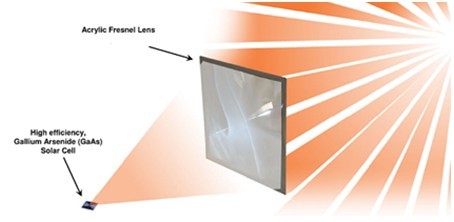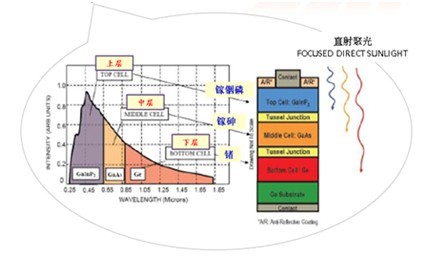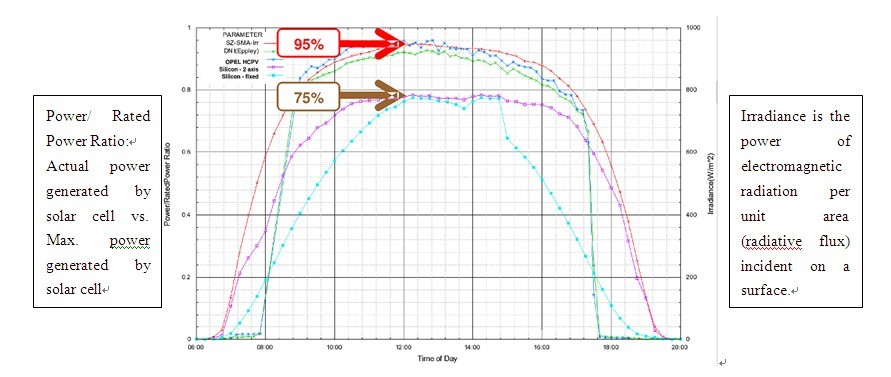SERVICE
- Lighting knowledge
- Lighting Design
- Solar energy photovoltaic power generation
- Ecotech HCPV services
- Download
Introduction of HCPV
Updated:2013-07-02Hits:2885
The New Energy Development
The energy problem has become a bottleneck restricting the international socio-economic growth. Due to the shortage of coal, petroleum and other non-renewable energy, more and more countries have begun to develop renewable energy. Solar photovoltaic power generation is an important focus of development.

The solar cell development
Solar cell is the core component of the solar photovoltaic power generation system. The power efficiency is based on a variety of semiconductor materials and structures. With three generations of solar cell technologies, each generation of solar cell is significantly evolving towards high efficiency.

- Currently, polysilicon and monocrystalline silicon which are the first generation of solar cells are installed mainly at the large scale power generation stations.
- Thin film solar cell is the second generation of solar cell. The major materials include amorphous silicon, cadmium telluride, copper indium selenide, copper indium gallium selenide, etc.
- The major materials of the third-generation solar cells are the III-V and II-VI crystalline compound. By using difference chip structure, such as the triple-junction gallium and arsenic compounds, the solar photovoltaic efficiency of mass-produced chip can be achieved to 38% - 40% and the module DC power generation efficiency is 24% - 29%.
High Concentrating Photovoltaic (HCPV)
Generally, the third-generation solar cell adopts high condenser optical components and dual-axis tracker to collect focused direct sunlight. The operating area of the chip can be reduced to 1/1000 – 1/2000 of the crystalline silicon with the same power output. This technology is known as the high concentrating photovoltaic (HCPV).
The optical principles of refraction of high-concentrator solar cell module and the structure diagram of 3JGaAs solar cells.



Advantages of CPV:
· Module energy-conversion efficiency is high, the efficiency of chip is 1 times higher than crystalline silicon;
· CPV system can absorb visible light, near-infrared and infrared; but crystalline silicon absorbs only part of the visible light and near-infrared;
· Operation at high temperature can maintain good efficiency continuously. The efficiency of silicon panels decreases rapidly with temperature (25%). But CPV system retains its efficiency (only slight drop 5%), even in hot climate;
· Depreciation is slower than the crystalline silicon and an annual average is about 0.3% -0.5%;
· Low-pollution: The operating area of the CPV is 1/1000 – 1/2000 of the crystalline silicon. Low pollution and damage to the environment;
· Low power consumption: the energy consumption of the entire CPV system is about 60% -75% of crystalline silicon under the same power output.

Economic Benefits of HCPV Technology
In the next few years, the price trend of HCPV is expected to decline as compared to other technologies.
.jpg)
HCPV of Ecotech
Ecotech HCPV system uses solar cell module of the United States and dual-axis tracker of Spain. It can achieve an extremely high level of tracking accuracy within ±0.3°. Also, the system uses GPS positioning signals to fully convert sunlight into electrical energy. By using strict structure design and international advanced CAD software, wind tolerance limits can be reached to 13 grade or above. Ecotech HCPV system is recognized in the industry and well-known at the local and even overseas markets.
Ecotech formed a joint venture with OPEL Solar, Inc. of the United States (www.opelinc.com) and set up a R&D and Technology Center of HCPV in Hong Kong to jointly develop the PV market in Asia. Meanwhile, we have started to a series of new inventions and design patent. Nowadays, we possess a number of international leading concentrator photovoltaic design patents. Our products and trades are distributed throughout the world.



